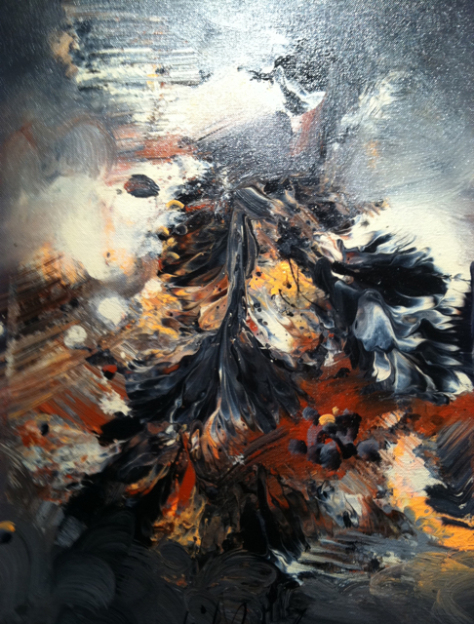Here is the one completely abstract image from Zhong’s recent exhibition. The element of abstract expression in Zhong’s work is particularly interesting given the acute realism of the better part of his art. The realism, a result of his use of digital photographs which he projects on to canvas, and then paints in acrylic with or on top of charcoal rendering, is the mainstay of his imagery. In recent years, though, these realist slices of life are increasingly accompanied by non-representational imagery, masses of colors, swaths of texture. This is a bold maneuver for an artist who was already completely successful with his method. In other words, continuing indefinitely on the path he’d pioneered was not only a viable option, it was the obvious choice. Nonetheless, he undertook a new direction, albeit on which is entirely integrated into his juxtapositionary method.
The San Francisco exhibition (mentioned below) contained one purely abstract image. Even with the departure, entirely abstract pictures are still very rare in Zhong’s work. They are a rarity, indeed, at all in artistic practice, and China is no exception. Indeed, given the fact that the value of Chinese art on the market of late–and by that I mean now already a few decades, though the recent surge is worthy of note–has mostly to do with the fact that these are Chinese art works. Once an artist begins to work in the solidly abstract mode, though, such “Chineseness” falls out of view. Below is “Complex”
I find his abstract work successful, and this painting especially. (Its worth noting that the lighting at the top of the image and blurriness center left is due to my bad photography and not the canvas itself). This is because I still se a good deal of Zhong’s stock imagery, the flowers blooming, the explosions, human flesh both adorned and not, and so many material objects of the “solid poetry” of China’s built environment. Yet, of course, there is nothing here to actually suggest this much less represent this. It is, instead, a representation of “complex,” in the psychological condition sense, and as such remains subterranean. Such representation properly defies symbolic treatment, something which we do not expect to emerge until figures provide avenues of legibility. The gesture is thus a purifying one, opening a clearing in preparation for the next time meaning comes around.
